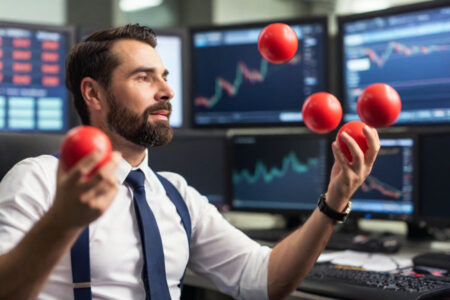
Cross-asset trading is exactly what it sounds like: trading multiple asset classes to diversify a portfolio and better manage risk. With a single point of execution, the strategy has the potential to reduce operational costs and increase efficiency – but measures need to be taken before a team can get out of siloed structures.
Global Trading speaks to Andrew Etherington, head of multi-asset total return at AXA Investment Managers, and Antish Manna, principal quant and head of execution analytics for central trading at Man Group, about what it takes to run a cross-asset desk – and why the strategy is effective in a tumultuous landscape.
The year so far
In a string of unprecedented years, 2025 has provided its fair share of challenges so far. From tariff back-and-forth to global conflicts and rapidly-developing technology, both volatility and overall uncertainty have been front of mind.

“Momentum has been upended by policy uncertainty with bouts of intense intraday volatility which has left the appreciation of markets from a valuation perspective largely redundant. It’s been a helter skelter of a ride,” Etherington reported.
AXA IM’s multi-asset strategy covers equity, fixed income, currency and commodity assets.
“In terms of asset allocation, we had the peak of volatility in April. It’s come down across all asset classes, and that encourages the quantitative style systematic strategies to re-engage with risk. They’re reengaging slower than they sold off, and that’s because they need past volatility to wash out of their data set.”
Etherington highlighted the changing role of central banks, noting that many in the industry have not worked during a time when central banks were not taking a ‘hand-holding’ approach.
“In fixed income, there’s a steepening trend on global yield curves. Central banks have been stepping back from intense forward guidance.”
During times of stress and change, agility is crucial; and that’s where cross-asset strategies can come in.
“You need things under the hood for when things inevitably go wrong,” Etherington stated at TradeTech in Paris earlier this year. The benefits of diversification are increasingly apparent, and for traders working in a climate they’re not used to, being prepared is key.
Structure
One of the most important things for cross-asset desks to succeed is also one of the simplest: having everyone in the same place.
“I’ve been in places before in my career where the fixed income desk would be on a

different floor from equities, with very little to no interaction. Different toolkit, different philosophies on how you approach the market and trade. It’s a missed opportunity,” explains Manna.
At Man Group, traders of all disciplines sit together – across asset classes and across strategies.
“We have high-touch traders covering markets where there’s little or no electronification and automation, then we have quant traders and researchers looking at the systematic side of the business and optimising our algos,” Manna illustrated.
“It’s beneficial for people to sit together. We centralised trading in 2018, we’re in the seventh year of being one team, one unit servicing the whole of Man Group without silos.”
Beyond physical structures, cross-asset trading desks also allow people to spread insights and learnings across asset classes.
Having the team all in one place allows for operations to improve more quickly, Manna continued. One those on the strategic side of the business have optimised the operations of the market they’re covering as much as possible they’ll jump onto another project, bringing their learnings with them.
“That lets us reallocate resources to make maximum return on investment,” he said.
“There will be areas where you can reach an optimisation plateau, but you can reuse the same transferable skill set – of understanding markets, modelling cost, automation, algo optimisation – in other markets where the opportunities are still untapped.
“Sometimes when people are only looking at one market, they’re limited as to what they view as possible. A side effect of having people move around is that they start to see things in common across the business, often augmenting what they then see as possible.”
Speaking the same language
Key to enabling this is having a shared, standardised language and toolkits, which allows traders to move between disciplines without having to learn new ways of operating.
“That’s one reason why our team is very fluid in terms of people’s ability to pick up new asset classes. If you have a really good understanding of venue toxicity, you can apply that from one asset class to another without having to relearn things, but at the same time doing so without diluting our very laser focused way of dealing with specific markets in specific ways,” Manna said.
“In periods of market stress, it is equally useful to know where you don’t have to focus,” he noted. “Without a strong communications and operations framework across the board, critical information and insights can be lost, dampening the overall confidence in the process. You want simple, clear, and data-backed insights.”
Challenges between asset classes
Jumping from one asset class to another isn’t always easy, though, no matter how well-aligned operations are. Some markets are more liquid, some are more electronic, regulation is lagging in some and information is harder to come by in others.
On the liquidity side, Etherington emphasises AXA IM’s focus on remaining nimble when juggling various asset types.
“Our clients require daily liquidity, so all our assets could be liquidated in a couple of sessions. We have to be careful that we’re able to get in and out,” he says.
“In a futures market, it’s not always sufficiently liquid to do that comfortably, especially in a time of stress. Even with listed options, when the market takes a significant shift higher in stress, bid offers go out and a lot of the profit and loss that you would have expected to be able to realise disappears. You have to be conscious of that – you can’t rush into every instrument.”
This requires a level of specialism from cross-asset teams, alongside their ability to cover multiple instrument types concurrently. That’s where high-touch traders come in, Manna says, explaining how Man balances specialism and generalism.
“High-touch traders usually have a business or type of business that they’re servicing. They have a really rich understanding of their PMs’ intentions and the names and markets they are in every day.”
Discrepancies between asset classes don’t stop at the point of execution; they need to be taken into consideration during trade cost analysis (TCA) too.
“TCA works differently across asset classes because the underlying asset classes trade differently. When you try to pull it all together, you realise that you’re measuring different things, and there’s a question mark over what you’re going to end up with,” commented Matt Howell, global head of trading strategy at T Rowe Price, at TradeTech this year.
“It’s becoming increasingly important as different asset classes bleed into each other.”
Ash Sharma, global trading analytics manager at Aviva Investors, explained at the event that TCA is still siloes at his firm. “We’re hopefully moving to the stage where we’ll be able to look at all the costs associated with each of the asset classes within a fund, in terms of the instruments that are traded,” he said. “There are always ways to refine the analytics that you’re looking at, whether they’re in-house or outsourced.”
Both AXA IM and Man Group declined to share the names of service providers used by their cross-asset desks.
It’s unlikely that high levels of volatility and uncertainty will come down any time soon. While specialist knowledge is still a valued part of the trading environment, the flexibility and agility that generalist traders – and those willing to break out of their silos – can provide are increasingly in demand as the industry, and the challenges it faces, evolve.

